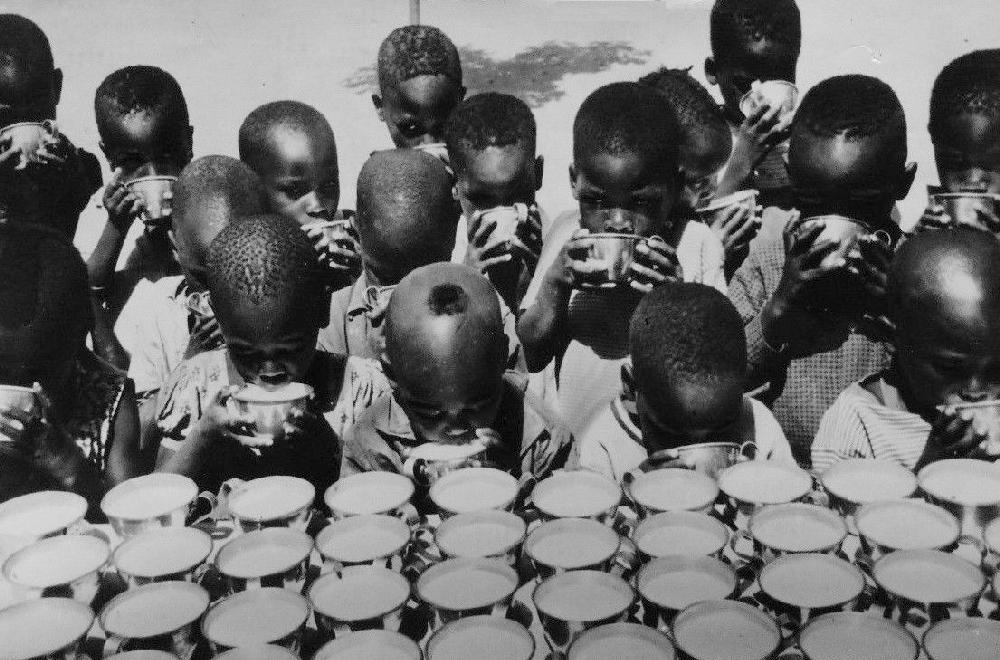
Chad Schools

Figure 1.--This photograph of a school feeding effort in Chad appearesd in a Polish newspaper during 1964. The children are having a milk break. The press caption read, "W nowo wyzwolonych krajach Afrykl wiele starań i uwagi poswieca sie oświacie i wychowaniu, przy czym wychowanje rozpoczyna sie już w bardzo wczesnym wieku, od żiobków i przedszkoli, Tak wyglada jedno z niedawno otwartych przedszkoli w afrykańskie republice Czad." That translate as "In newly liberated African countries, a lot of effort and attention is devoted to education and upbringing, and the upbringing starts at a very early age, from nurseries and kindergartens. This is what one of the recently opened kindergartens in the African republic of Chad looks like." The Soviet Union and its satellites had aforeign policy of supporting tghenewly independent countries. And there was support for revolutionary groups. There was, however, little development aid. In particular there was little food assistance, in part because Communist policies meant that there was domesticfoodshortages.
|
|
We know nothing about education in Chad until the modern era. Presumably therewassomesort of training for the ruling class in the various kingdoms or chieftanates. Mosques also likely hadsome kind of basic education. It was not until the arrival of the Europeans that education in the modern sence reached Chad, actually sometime after the Europeans first arrived. The first schools we note were established by Protestant missionaries (1920s). They set up mission schools in the non-Islamic south. French colonial authorities required that all schools be conducted in French. An exception was religion classes. This apparently included instruction at mosques. French authorities fiollowing theFrench education system created a standard curriculum imposed on all educational institutions desiring official recognition and government financial support. The schools established were primary schools. There were no secondary schools. Young people who wished to pursue secular education beyond the primary level. Some children went to Brazzaville (now in the Republic of the Congo), but this meant only small number of children were involved. The first secondary school in Chad opened (1942). It was, however, not for a decade that the certificate academic levels were recognized by French authiorities (mid-1950s). Chad achieved indepencence (1960) and like other newly independent African countries placed apriority on expabding the education system. The immediate goal was universal primary education. The Government made school attendance compulsory until 12 years of age. Mandating this an achieving it were two different matters. The Government faced numerous in aschieving its educational goals. The development of a national standard currucula was a problem. The Government phased a range of problems. There were an inadequate number of schools. And the ones that existed were mostly 2-3 year schools. There were a verry small number of 5- and 7-year collèges and lycées. Another issue was the Muslim preference for Quranic education. Many parents were hesitant to send their children to school, especially Muslim parents. Here there was special concern with the girls. The Government reported that some 17 percent of students between the ages of 6 and 8 years were in school (mid-1960s). Quranic schools throughout the northern Saharan and Sahelian zones teach students to read Arabic and recite Quranic verse. Modern Islamic secondary schools have a wider curriculum, such as the Ecole Mohamed Illech, founded in 1918. The country has continued to expand education, but the system is still limited. Problems include the size ofthe country and the dispersed population, especially in the north, and limited resources. Parental resistance continues to be a problem. Muslim parents in particular are concerned about secular education, especially for girls. Mission and Quranic schools continue to function. Considerable progress was made (1970s-80s). Available estimates vary. One source suggests that 70 percent of boys today continue education beyond the primary level, but this may be optimistic. The proportion of girls is substasntially lower. Literacy is increasing, but over half of the population is still illiterate. There is now the University of N'Djamena (1971). It offers higher education.
HBC

Related Chronolgy Pages in the Boys' Historical Web Site
[The 1880s]
[The 1890s]
[The 1900s]
[The 1910s]
[The 1920s]
[The 1930s]
[The 1940s]
[The 1930s]
[The 1940s]
[The 1950s]
[The 1960s]
[The 1970s]
[The 1980s]
Related Style Pages in the Boys' Historical Web Site
[Long pants suits]
[Knicker suits]
[Short pants suits]
[Socks]
[Eton suits]
[Jacket and trousers]
[Blazer]
[School sandals]
[School smocks]
[Sailor suits]
[Pinafores]
[Long stockings]
Navigate the Boys' Historical Clothing Web Page
[Return to the Main African school page]
[Return to the Main Chad page]
[About Us]
[Activities]
[Chronology]
[Clothing styles]
[Countries]
[Debate]
[Economics]
[Garment]
[Gender]
[Hair]
[History]
[Home trends]
[Literary characters]
[School types]
[Significance]
[Transport and travel
[Uniform regulations]
[Year level]
[Other topics]
[Images]
[Links]
[Registration]
[Tools]
[Return to the Historic Boys' School Home]
Created: 2:59 AM 2/7/2019
Last updated: 3:00 AM 2/7/2019




